A Guide to Strikepod Fiction

In addition to analysis, we have published an array of fiction products ("fiction intelligence" or FICINT) to illustrate the coming threats and opportunities of autonomous undersea conflict. Below are links to stories, designs, as well as a full glossary of the vehices, technologies, operations, and people populating the world of Strikepod Systems.
DESIGNS:
- The Atom-class Microsubmarine (Block I, Block II, XE)
- The Esquire-class Microfrigate
- Autonomous Undersea Denial Networks (AUDENS)
- The IRIN/IRGCN Azhdar UUV
EUROPA:
We have also used fiction to explore the deployment of microsubmarines on the watery worlds of our solar system, specifically, the Jovian moon Europa.
PUBLICATIONS:
Strikepod fiction has been published by the Center for International Maritime Security (CIMSEC) and Divergent Options:
-
Operation Indigo Spear and the Second Tanker War of 2022
Center for International Maritime Security (CIMSEC)
cimsec.org -
Alternative History:
An Assessment of the Islamic Revolutionary Guard Corps Navy Azhdar Unmanned Undersea Vehicle
Divergent Options
divergentoptions.org -
Operation Eminent Shield and the Advent of Unmanned Distributed Maritime Operations
Center for International Maritime Security (CIMSEC)
CIMSEC.org -
The Nanxun Jiao Crisis and the Dawn of Autonomous Undersea Conflict
Center for International Maritime Security
CIMSEC.org -
The Battle of Locust Point:
An Oral History of the First Autonomous Combat Engagement
Center for International Maritime Security (CIMSEC)
CIMSEC.org
GLOSSARY OF FICINT TERMS
Updated: 15 April 2020
ABLE
A Strikepod deployed to ICEX 2018, which, together with Strikepod Banner, engaged three Istina-class microsubmarines that breached the exercise perimeter and harassed the USS Connecticut, passing within meters of her hull before escaping.
ARCHER
A Strikepod deployed during Operation Nøkken I, which, using the CLAXEM module, successfully spoofed a Russian Akula-class submarine and IL-38 maritime patrol aircraft by generating a decoy submarine using both acoustic and magnetic emissions.
ADSEWA
The Atom-class Advanced Seabed Warfare (ADSEWA) module houses a suite of improved undersea communications and electronic warfare technologies, as well as highly advanced pressure, magnetic, and acoustic sensors, including the Seabed Static Array System (SEASTAR).
Alpha Pod
The very first active duty Strikepod, Alpha deployed to the Chesapeake Bay in September, 2016, to guard the USS Zumwalt and other U.S. naval vessels as part of Baltimore Fleet Week. Alpha also took part in Operations Robust Probe/Robust Purge, and the Battle of Locust Point.
Amber
Project AMBER took place during ICEX 2018, to assess the viability of the Strikepod as a full-spectrum Arctic seabed warfare platform versus fixed undersea infrastructure, or the placement of static bottom munitions or CAPTOR-style mines. Atom-class microsubmarines assumed the role of sensors and effectors - sonar arrays, communications nodes, weapons - and were configured as mobile, hovering, or fixed Strikepods, engaging simulated targets both on and below the surface while dynamically reconfiguring to compensate for simulated losses or malfunctions.
Atom-class
The Atom is a United States microsubmarine leveraging state of the art microtechnologies. Atoms operate in Strikepods, distributed networks of microsubmarines programmed to execute missions of varying scale and complexity, such as anti-submarine warfare (ASW), intelligence, surveillance, and reconnaissance (ISR), mine countermeasures (MCM), and precision undersea strike.
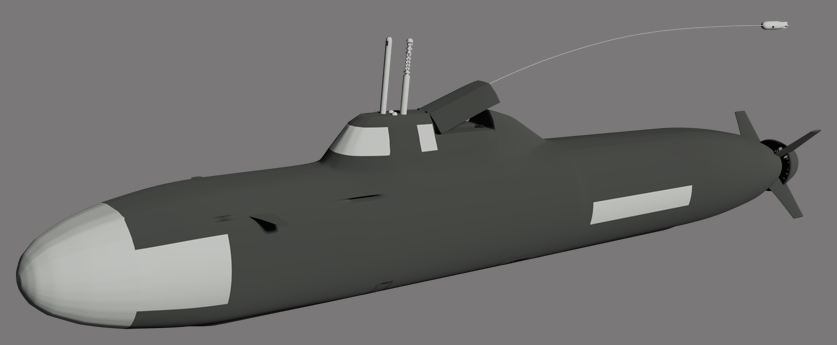
Concept Art: Dhimas Afihandarin
Atom-class: Block II
The Block II Atom-class, unveiled in May, 2019, is an order of magnitude beyond the Block I, and features enhanced situational awareness, cyber operations, and nuclear propulsion.



Concept Art: Dhimas Afihandarin
AUDEN
An Autonomous Undersea Denial Network is an integrated undersea system comprised of Block I and Block II Atom-class microsubmarines and associated infrastructure designed to provide persistent, wide-area deployment of Strikepods. Though conceived shortly after the Battle of Locust Point, the AUDEN concept acquired a renewed sense of urgency in light of Russian "doomsday UUV" Poseidon, and the need to defend CONUS against this and other micronaval threats.
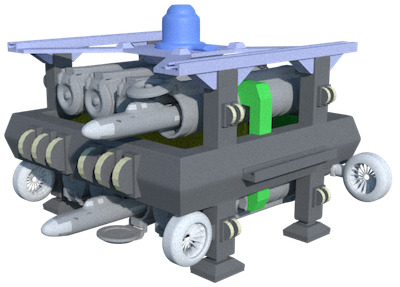
AUDEN Module. Concept Art: Dhimas Afihandarin
AUDLANT
The Atlantic Undersea Defense Network is a proposed defensive network charged with defending the east coast of CONUS against conventional and micronaval threats.
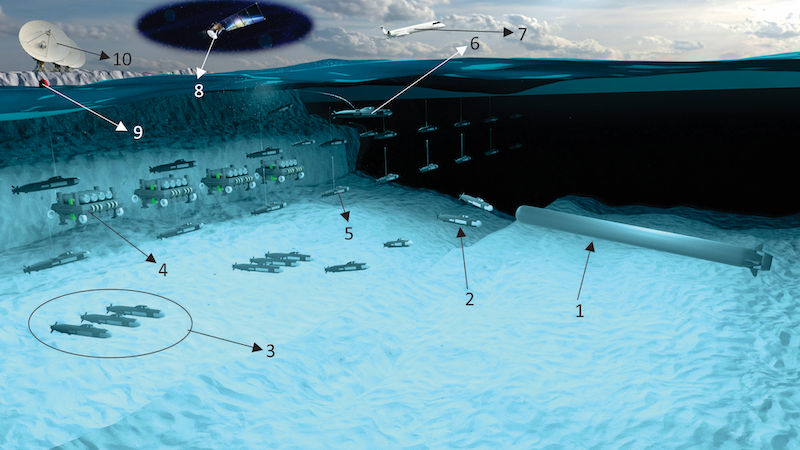
Concept Art: Dhimas Afihandarin
Azhdar
The Azhdar is an Iranian UUV based on the IRIN e-Ghavasi swimmer delivery vehicle (SDV). It is suspected that four of these vehicles were used to carry out the May 12, 2019 tanker attacks off Fujairah, UAE.
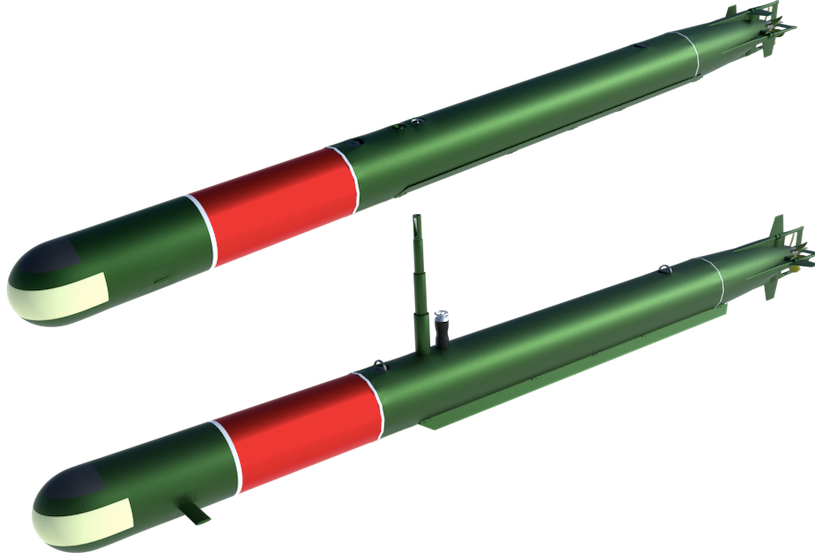
BANNER
A Strikepod deployed to ICEX 2018, which, along with Strikepod ABLE, engaged three Istina-class microsubmarines that breached the exercise perimeter and harassed the USS Connecticut, passing within just eight meters of her hull before escaping.
Beta Pod
A four vehicle pod comprised of two Rogues (Rogue-1 and Rogue-2) and two Relays, Beta joined Operation ROBUST PROBE on September 18, 2016. Beta successfully rendezvoused with Alpha Pod, and swapped Rogue-1 for the Alpha Rogue, which was experiencing propulsion problems and returned to base. Rogue-2 and Beta Relays then took up station near the mouth of the Patapsco River, while Alpha continued to patrol south of the Bay Bridge.
BLACKJACK
A twelve-ship Strikepod deployed during Operation Nøkken II, BLACKJACK successfully dispatched RUNABOUT, a single Atom-class microsubmarine, on a mission to successfully penetrate Russian naval networks utilizing its onboard Minuet system to generate decoy undersea communications and data transfers.
Chandra Devareddy
ONR (Office of Naval Research) laison to the Atom-class program and commander of Strikepod Forces, Pacific who was killed in an explosion aboard the USS John Warner caused by a malware exploit in the Block IV Atom that disabled the LENR’s automated kill switch and caused a cascade overload.
Charles Alan Ordway
A FathomWorks contractor whose spying for the Chinese led to the exposure of CYAN, and the deaths of four Chinese nationals during operation Operation Roundhouse.
Chesapeake Bay Incident
In early 2016, a disabled Russian Istina-class microsubmarine was recovered off the coast of Cape Charles, Maryland, setting in motion a series of events that would culminate in the first undersea combat engagement of the micronaval era, the Battle of Locust Point.
Chorus
The order given to a CLAXEM-equipped Strikepod to generate an acoustic submarine signature decoy.
Clandestine Access and Emission Module (CLAXEM)
The CLAXEM module is an information warfare module for the Atom-class microsubmarine. It is capable of generating the acoustic and magnetic signatures of a range of adversary and allied submarines, with the combined emissions of a CLAXEM-equipped Strikepod capable of a creating a decoy of larger undersea craft. The CLAXEM module is also equipped with Minuet, a suite of covert undersea communications technologies that enables the clandestine penetration of adversary undersea data networks for covert surveillance and/or deployment of offensive cyber weapons.
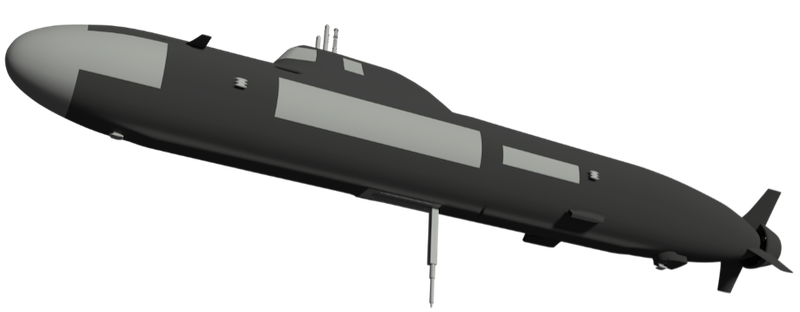
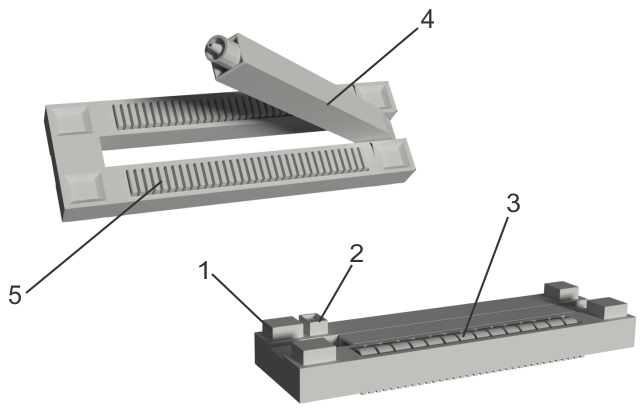
EXTERNAL CLAXEM ASSEMBLY: 1.Internal attachment point. 2. Direct data and power interface port to carrier. 3. Undersea transmit/receive array. 4. Repeater cable tapping assembly. 5. External magnetic attachment point.
Classic-1, Classic-2, & Classic-3
Codenames for three Russian Istina-class microsubmarines identified and tracked during Operation Robust Probe, and eventually destroyed during Operation Robust Purge.
CYAN
The CIA codename for Xin Li, a Chinese offshore diver assigned to Nanxun Jiao who provided intelligence on an undersea microsubmarine turret which was later destroyed by Strikepods during Operation Roundhouse.
DUMO
A Dipping Undersea MOdem, used by surface or air (rotary wing) assets to communicate with undersea platforms. See also: SUMO.
Echo-1 & Echo-2
On August 2, 2017, while prosecuting Operation Noble Prowl, Strikepods Echo-1 and Echo-2 engaged four hostile DPRK Gwisin-class microsubmarines while enroute to prosecute an unidentified North Korean submarine operating in the Yellow Sea.
Embedded Remora Module (ERM)
Employed by the Atom-class microsubmarine when in Remora mode, the ERM features a high-powered electromagnet for securing to metallic hulls and other surfaces, as well as a Turbo-Injected Quadhook (TIQ) assembly for securing to rubberized (i.e. anechoic) surfaces.
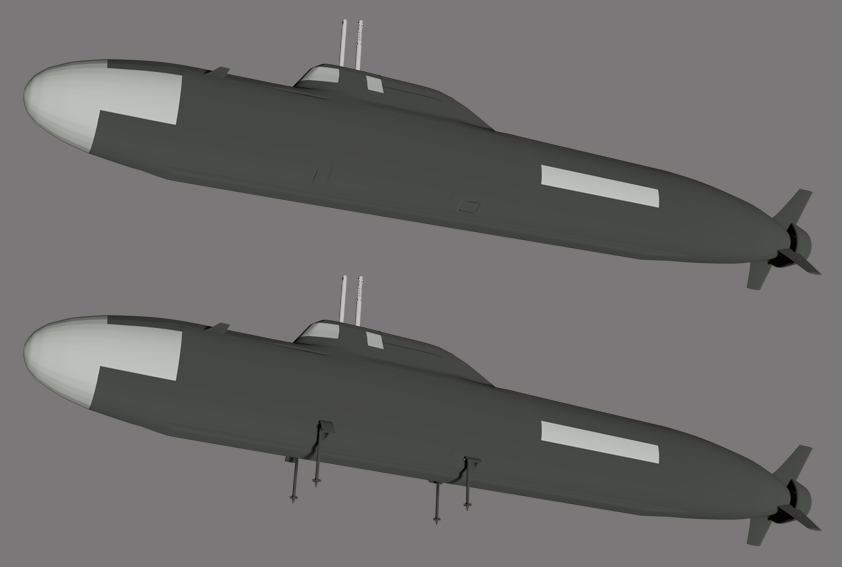
Concept Art: Dhimas Afihandarin
Eminent Shadow
A large-scale microsubmarine deployment to the South China Sea, where Strikepods are currently monitoring the waters near Fiery Cross, Subi, and Mischief Reefs for PLAN surface and undersea operations.
Eminent Shield
An unmanned distributed maritime operation in the South China Sea comprised primarily of Strikepods and Esquire-class microfrigates. The objective of Eminent Shield was to contain and, if possible, roll back the PRC's expansionism in the region, which had most recently taken the form of Shāyú microsubmarine emplacements off the coast of Bombay Reef and Scarborough Shoal.
Esquire-class
A proposed first generation unmanned microfrigate, the Esquire-class is a micronaval variant of FFG(X). With a mission to defeat threats in the microbattlespace, the Esquire-class utilizes nanomissiles, self-guided nanoprojectiles, and directed energy weapons to defeat enemy drone aircraft as they become ever smaller and more maneuverable. Esquires can be produced in larger numbers than the proposed procurement profile for FFG(X) (one unit in 2020 and 2021, with two in each of the following nine years), and at a markedly reduced cost. A network of unmanned Esquires would reduce the demand on high end combatants, minimize the risk to human life, and extend the tactical grid well beyond the horizon.
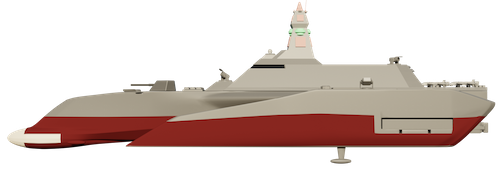
Concept Art: Dhimas Afihandarin
FathomWorks
A colloquialism for the Joint Undersea Initiatives Group, FathomWorks is a consortium of leading defense contractors and specialized units of the United States Navy, Coast Guard, and Marine Corps charged with, among other things, developing a coastal undersea network to defend against foreign micronaval threats.
FFG(X)-M
See Esquire-class

Firesquid
The Firesquid is a microtorpedo for use against unmanned underwater vehicles, and as an anti-torpedo torpedo (ATT). The Esquire-class microfrigate houses twelve Firesquids with two integrated "drawer" launchers located in each outrigger.
Foxhawk
The MQ-100 Foxhawk is a fixed-wing, turbofan powered swarming UAV that is launched from the Esquire-class Mark-41m Vertical Launch System.



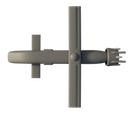
Concept Art: Dhimas Afihandarin
Gamma Pod
A five ship Strikepod comprised of one Rogue, two Relays, and two Remoras, Gamma joined Operation ROBUST PROBE on September 23, 2016, to patrol an area near Smith Island in the Chesapeake Bay.
GOBLIN
Codename for the Akula-class submarine successfully spoofed during Operation Nøkken I, when CLAXEM-equipped Strikepod ARCHER generated the acoustic signature of a Los Angeles-class submarine.
Gwisin-class
The Gwisin is a North Korean microsubmarine based largely on the Russian Kilo-class. The stern section, however, is nearly identical to that of the Shāyú-class, suggesting that the DPRK has benefitted from technical assistance from the Chinese. In August, 2017, Strikepods Echo-1 and Echo-2 engaged four Gwisins while prosecuting a manned DPRK submarine in the Yellow Sea.

Concept Art: Dhimas Afihandarin
HENID
The High Energy Intercept and Disrupt (HENID) system is an advanced directed energy weapon system carried by the Esquire-class, and is used to engage inbound airborne threats. While HENID is intended as a close-in weapons system (CIWS), its effective range is 2 km, or 1 nautical mile.
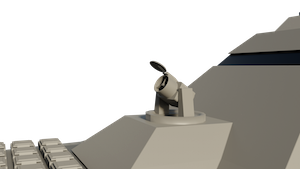
Concept Art: Dhimas Afihandarin
Indigo Cloak
A Strikepod/Esquire deployment currently underway in the Persian Gulf with a mission to patrol for IRCGN Qom-class microsubmarines. Operation INDIGO CLOAK began in October, 2017, with Strikepods engaging in mine countermeasures (MCM), intelligence, surveillance and reconnaissance (ISR), and anti-submarine warfare (ASW). On April 14, 2018, Strikepods defending the destroyer USS Higgins (DDG-76) engaged a swarm of twenty four Iranian Qom-class microsubmarines in the hours leading up to strikes against Syrian chemical weapons installations.
Indigo Spear
A combined WARCOM/PODCOM special operation organized in response to Azhdar attacks on Persian Gulf shipping, Indigo Spear involved the use of Strikepods and Esquires to detect, track, and disrupt Iranian Ghadir-class submarines in coordination with SEAL Rapid Interdiction Platoons (RIPs).
Istina-class
The Istina is a Russian microsubmarine based on the Oscar II SSGN. It is equipped with a wide range of advanced undersea communications technologies and sensors, including flank, bow, and topside sonar arrays, front and rear facing high definition video, and a micro-SOKS system for wake detection. In September and October of 2016, a disabled Istina-class microsubmarine was recovered off the coast of Cape Charles, Maryland, setting in motion Operation ROBUST PROBE/ROBUST PURGE during which three additional Istinas were found to be lurking in the Bay, and were eventually destroyed during the Battle of Locust Point. Istinas have also been detected near several east coast naval installations, and are suspected to be responsible for the August, 2017, "scuba diver" sighting inside a secure area at Naval Station Norfolk.

Concept Art: Dhimas Afihandarin
Jeremy Baynes Lacy, USN
Widely considered the father of autonomous undersea conflict, or what has come to be known as micronaval warfare, Admiral Jeremy Baynes Lacy spearheaded the Atom-class microsubmarine program, eventually going on to establish Strikepod Group 1 (COMPODGRU 1), and serving as Commander, Strikepod Forces, Atlantic (COMPODLANT) and Strikepod Command (PODCOM). He served at sea aboard the USS Pennsylvania (SSBN 735), USS Henry M. Jackson (SSBN 730), USS Springfield (SSN 761), and the USS Pogy (SSN 647), deploying to the North Atlantic, Arctic, and Western Pacific, as well as conducting numerous strategic patrols. Ashore, Lacy earned a Masters Degree from the Naval Postgraduate School in Naval/Mechanical Engineering, and served as Major Program Manager for Undersea Project 7, the Atom-class microsubmarine program. Admiral Lacy is currently enjoying his “retirement” as the Corbin A. McNeill Endowed Chair in Naval Engineering at the United States Naval Academy.
Joint Undersea Initiatives Group
See FathomWorks
Lake Talia
A nickname given to Nassi Marine headquarters for its enormous wave pool and micronaval testing facility. (See Nassi Marine)
LENR
A Low Energy Nuclear Reactor (LENR) powers both the Block II Atom-class microsubmarine and the Esquire-class microfrigate. It is a small, lightweight, "cold fusion" microreactor providing high energy density, enabling missions of unlimited range and endurance.
Locust Point
The first combat engagement of the autonomous undersea era, the Battle of Locust Point took place in the Chesapeake Bay on October 14, 2016, just below the surface of Baltimore Harbor during Fleet Week. Three Strikepods of U.S. Atom-class microsubmarines engaged and destroyed three Russian Istina-class microsubmarines after they infiltrated the Bay, and attempted to breach a secure area where the U.S. Navy's stealth destroyer, USS Zumwalt, as well as USS Jason Dunham and USS Leyte Gulf were docked.
Magnetic Anamoly Detector (MAD)
One of several non-acoustic sensors aboard the Block II Atom-class microsubmarine, the MAD detects slight variations and distrurbances in the Earth's magnetic field which can be produced by a large metallic object such as a submarine, and is fully integrated with the CLAXEM, enabling the Atom to emulate adversary magnetic signatures during decoy engagements. The effectiveness of the MAD is greatly enhanced during Strikepod operations when Block II Atoms are dynamically linked to generate a wide-area undersea sensor array.
Max Keller
Director of Artificial Intelligence for the Atom-class program, which led to the development of Falken, the cross-platform, multi-domain AI forming the backbone of Distributed Maritime Operations (DMO).
Minuet
A suite of covert undersea communications technologies, including highly advanced signal processing and cryptologic algorithms, Minuet integrates with the Atom's onboard acoustic communications system to effectively transform it into an adversary network node, enabling the clandestine penetration of adversary undersea data networks for covert surveillance and/or deployment of offensive cyber weapons.
Mosaic
The order given to a CLAXEM-equipped Strikepod to generate a magnetic submarine signature decoy.
MQ-100
See Foxhawk
Nanxun Jiao Crisis
The first major confrontation of the Micronaval Era, the Nanxun Jiao Crisis began when the CIA's station in Manila received a letter containing information regarding an undersea microsubmarine battery off the coast of Gaven Reefs in the Spratly Islands. During a FONOP in the area, the USS Decatur and its Strikepod escorts were attacked by Chinese Shāyú-class microsubmarines launched from the batteries, prompting the United States to launch a strike on the facility during an operation codenamed Roundhouse.
Nassi Marine
Founded by Talia Nassi, Nassi Marine is a naval engineering company headquartered in Olney, MD, focusing on the development of cutting-edge unmanned surface systems, most notably the Esquire-class microfrigate.
Noble Prowl
A series of Strikepod patrols closely monitoring the waters surrounding the Korean peninsula, with a particular focus on Sinpo and Mayang-Do. Patrols are aggressively tracking DPRK submarines in both the Sea of Japan and Yellow Sea, and are on high alert for indications of SSB activity. It was while prosecuting Operation Noble Prowl that two Strikepods engaged four North Korean Gwisin-class microsubmarines while enroute to track a DPRK submarine in the Yellow Sea.
Nøkken
A two-pronged operation that took place during Dynamic Mongoose 2018, Operation Nøkken I involved the deployment of a twelve-ship Strikepod comprised of Atom-class microsubmarines fitted with the Clandestine Access and Emission (CLAXEM) module. Upon detecting a Russian Akula-class submarine and IL-38 maritime patrol craft, the Strikepod utilized the CLAXEM technology to successfully generate an acoustic and magnetic decoy of a U.S. Los Angeles-class attack submarine. Nøkken II involved accessing Russian naval networks utilizing decoy communications and data transfers to test the viability of the module for covert SIGINT or offensive cyber operations.
Northern Swarm
A unique partnership with marine conservation and environmental organizations during which Strikepods are deployed to the waters off New England and Nova Scotia to protect the highly endangered North Atlantic right whale.
PACLANT
The Pacific Undersea Defense Network is a proposed defensive network charged with defending the east coast of CONUS against conventional and micronaval threats.

Concept Art: Dhimas Afihandarin
Pasban-class
Pakistan's foray into micronaval warfare, the Pasban has benefitted substantially from reverse engineering of commercial off-the-shelf products, as well as technical assistance from the Chinese. The hull form bears a striking resemblance to that of the Teledyne Gavia, while the stern appears similar in design to that of the Kongsberg's Remus 600, or China's Shāyú-class microsubmarine. The Pasban is highly modular, offering plug and play capability that enables a high degree of flexibility and quick mission turnaround. Reports indicate that the platform includes a "missile module" providing six vertical launch tubes which are used to deploy microbuoys like the Shāyú, but may also be capable of launching nanomunitions like the Indian Saaya.

Concept Art: Dhimas Afihandarin
PODCOM
Strikepod Command, headquartered in Norfolk Virgina.
Qom-class
Evidence indicating Iraninan interest in acquiring a micronaval capability surfaced in September, 2016, when a source within the IRCGN (Islamic Revolutionary Guard Corps Navy) revealed the existence of a program to develop an indigenous microsubmarine. An initial batch of approximately six vessels was deployed to the Persian Gulf to augment Ghadir-class operations, possibly as decoys, as an extension of ISR and ASW capabilities, or possibly armed for asymmetric attacks. It is unknown whether or to what extent Qoms are capable of operating in conjunction with manned platforms, or in coordinated attacks (i.e. swarming), as is the preferred tactic of the Iranian surface fleet. At 1.14 meters, however, it is likely to be used primarily in asymmetric attacks against smaller vessels, such as patrol boats, zodiacs, riverine command boats, or unmanned vehicles (surface and undersea), as well as vulnerable infrastructure.

Concept Art: Dhimas Afihandarin
Relay
A mission mode of the Atom-class microsubmarine, Relays enable communication between shore, space, surface, and undersea assets via a high performance undersea micromodem, and a Coiled Multifunctional Antenna Buoy (CMAB) for VHF/UHF/IIFF/SATCOM access.
Remora
A mission mode of the Atom-class submarine, Remoras provide target prosecution and time critical strike using the Atom's Embedded Remora Module (ERM) which provides a high-powered electromagnet for securing to metallic hulls and other surfaces, as well as a Turbo-Injected Quadhook (TIQ) assembly for securing to rubberized (i.e. anechoic) surfaces. Remoras are also a Strikepod's "first to fight" in the event of a microsubmarine combat engagement.
Retract Stripe
A seabed operation involving USS Jimmy Carter, Retract Stripe was instrumental in recovering debris in the wake of attacks on four oil tankers off the coast of Fujairah, UAE, which would confirm suspicion that sub launched UUVs were used in the attack.
Robust Probe
A continuation of ISR operations in the Chesapeake Bay in the wake of the Battle of Locust Point, Robust Probe guards against further incursions by Istina-class or other adversary microsubmarines. The operation was expanded in February, 2017, to include the middle Potomac River (in the wake of Istinas being tracked as far north as Hains Point), and would eventually grow to encompass the entire Chesapeake Bay, as well as the James and Elizabeth Rivers near Norfolk, VA.
Robust Purge
The follow-on to Operation Robust Probe, Robust Purge authorized the disruption and/or destruction of the Istina threat in the Chesapeake Bay, and would be the operational precursor to the Battle of Locust Point.
Rogue
A mission mode of the Atom-class microsubmarine, Rogues provide Strikepods with effective command and control utilizing the Atom's range of sophisticated sensory and communication technologies, as well as onboard signal processing, integrated data management, and machine learning provided by an NVIDIA Jetson Tx-2 embedded AI supercomputer.
Roundhouse
A strike on an undersea microsubmarine battery off the coast of Nanxun Jiao, the northern reef of Gaven Reefs, Roundhouse resulted in the complete destruction of the facility, but also led to the deaths of four Chinese offshore divers, one of whom was believed to be CYAN, the source of the Nanxun Jiao intelligence.
RQ-80
See Sibyl.
Saaya-class
India's debut microsubmarine, the Saaya-class, has benefitted heavily from years of indigenous AUV research and development which resulted in such successes as the Maya and AUV-150. Intelligence indicates that the Saaya is based on the Arihant-class ballistic missile submarine, and features an advanced sensor suite providing video and still imagery, satellite communications, magnetic anomaly detection, as well as a specialized "sniffer" spectroscopic capability to detect the presence of diesel emissions, presumably from Pakistani SSKs. In addition to a micro-USHUS integrated sonar, the Saaya also features side-mounted arrays similar to India's Kalvari-class (French Scorpène-class) submarine, as well as four integrated vertical launch tubes just aft of the sail capable of launching microbuoys or possibly nanomunitions.

Concept Art: Dhimas Afihandarin
SEASTAR
Incorporated into the Atom-class ADWESA module, the Seabed Static Array System (SEASTAR) is a passive microsonar array that deploys from a seabed-based Atom-class via a hatch located aft of the sail, and extends upward through the water column to a height of up to fifty meters. A towed version of SEASTAR is currently under development, which would greatly enhance the Atom's hull-mounted microsonar and enable a Strikepod to effectively act as a roving, large-scale sonar array and/or integrated minefield, providing wide operating coverage during A2/AD operations.
Shāyú-class
The PLAN's chief micronaval asset, the Shāyú, is modeled on China's proposed fourth generation SSBN, the Type-098. MASINT has confirmed that the Shāyú's propulsion is micronuclear in nature, enabling missions of potentially unlimited range and endurance. The microreactor powers a pumpjet propulsor, while the hull design features a "Tri" shaped stern, as well as a blended sail and diving planes, providing the Shāyú with impressive acceleration and maneuverability. "Missile" hatches along the top of the hull are used to deploy microbuoys during ASW operations, and to provide communications when surfacing is not possible, due to sea state or other impediment. Strikepods have engaged Shāyús in the South China Sea during Operations Roundhouse and Eminent Shadow.

Concept Art: Dhimas Afihandarin
Shilpa Devareddy
Director of NASA’s Europa Lander program, and daughter of Chandra Devareddy, and daughter of Chadra Devareddy.
SIBMOD
A payload module for the Esquire-class microfrigate providing additional hangar space for four RQ-80 Sibyl VTOL UAVs.
Sibyl
The RQ-80 Sibyl is a VTOL UAV utilized by the Esquire-class microfrigate. The Esquire can accommodate two Sibyls on its flight deck, and two within the permanent hangar bay. It can be configured with SIBMOD, a hangar module providing stowage of up to four additional Sibyls.
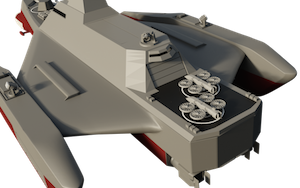
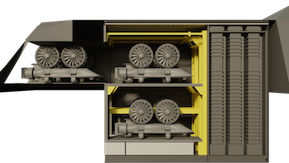
Concept Art: Dhimas Afihandarin
Status-6/KANYON/Poseidon
Also known as KANYON, or Poseidon, Status-6 is a Russian "intercontinental nuclear-armed undersea autonomous torpedo" designed not only to destroy coastal targets, such as ports and naval bases, but render those areas uninhabitable for nearly a century. Although the existence of Status-6 has been acknowledged by the Pentagon's 2018 Nuclear Posture Review, its purported capabilities - 100 MT warhead, cobalt-60 "salting," running depth of 1000 meters, range of 10,000 kilometers, speeds as high as 56 (or even 100) knots - have yet to be confirmed. The vehicle is scheduled to be deployed by 2027.
SUMO
A Shipboard Undersea MOdem, affixed to the keel or the hull beneath the waterline, a SUMO is used by surface assets to communicate with undersea platforms. See also: DUMO.
Talia Nassi
A maverick naval commander who took early retirement to start Nassi Marine, a naval engineering company fosucing on the development of cutting-edge unmanned surface systems, most notably the Esquire-class microfrigate.
TERMITE
Code name for the Russian IL-38 maritime patrol aircraft successfully spoofed during Operation Nøkken I, when CLAXEM-equipped Strikepod ARCHER generated the magnetic signature of a Los Angeles-class submarine.
Turbo-Injected Intercept Probe (TIIP)
The TIIP is engaged during clandestine penetration of enemy undersea networks via the Clandestine Access and Emulation Module (CLAXEM). Upon successful penetration and activation of the TIIP, data is written to the onboard computer, and may also be transmitted simultaneously to Strikepod Relays using a small transmit/receive array fitted to the CLAXEM itself, or via the Atom's smaller flank array. The Block I's Turbo-Injected Quadhook (TIQ) assembly has been superseded by the Block II CLAXEM's Turbo-Injected Intercept Probe (TIIP), which doubles as an anchor for attaching to rubberized (i.e. anechoic) surfaces.

Concept Art: Dhimas Afihandarin
Wake Element Detector (WED)
One of several non-acoustic sensors aboard the Bloack II Atom-class microsubmarine, the WED detects subtle refractive changes in the surrounding water, as well as traces of radionuclides and other chemicals left behind by adversary undersea craft. The effectiveness of the WED is greatly enhanced during Strikepod operations when Block II Atoms are dynamically linked to generate a wide-area undersea sensor array.
Xin Li
A Chinese offshore diver (CIA codename: CYAN) assigned to Nanxun Jiao who provided intelligence on an undersea microsubmarine turret which was later destroyed by Strikepods during Operation Roundhouse.
Xue Ji
An expert in cetacean echolocation and communication who’d utilized deep machine learning to develop a crude method of communicating with dolphins and sperm whales using their own language of clicks and chirps. The system was co-opted by the People’s Liberation Army Navy to enable covert undersea communications.
